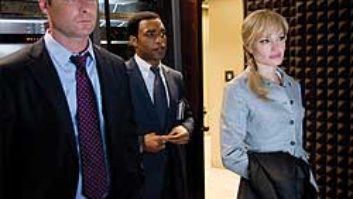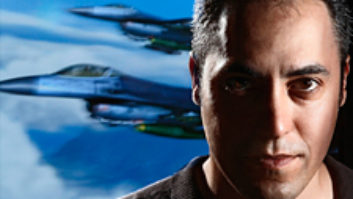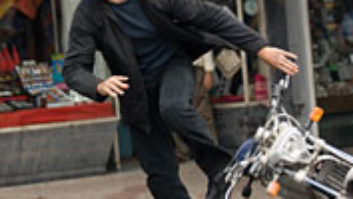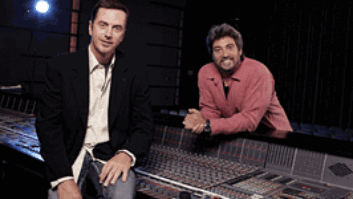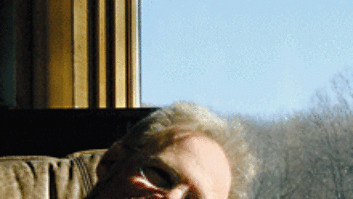The Sony Pictures Entertainment lot was abuzz at the end of May with the controlled rush to bring Mel Gibson and the drama of a family caught up in war to the big screen. From the remodeled Cary Grant to the William Holden and all-new Burt Lancaster theaters, with Foley and ADR working overtime and John Williams sessions in the historic scoring stage, the sound crew was, to quote re-recording mixer Kevin O’Connell, “all blazing.” The goal, from Lee Orloff’s production recordings to the preparation of tracks at Soundelux and the final mix at Sony, was to support picture and story in a natural way.
It seems so obvious that it makes you wonder why it hasn’t been done before: A big-budget action-drama about the Revolutionary War, with an A-list star, opening just before the July 4 weekend. (Okay, there was the 1985 turkey Revolution, with a miscast Al Pacino. Hollywood has a long memory when it comes to grosses.) But the possibilities appear endless, the landscape immense, with sweeping battles of red vs. blue and the inherent promise of the birth of a nation. Yet, when Columbia Pictures bought the screenplay for The Patriot, it was the family drama inside the historical drama that attracted the talent and pushed the picture beyond the typical summertime fare.
The Patriot balances the intimate and the epic on every level, from script to photography to acting, and certainly with sound. Mel Gibson plays Benjamin Martin, a guerrilla hero of the French and Indian War who has put his brutal past behind him and adopted the life of widower family farmer in South Carolina raising his seven children alone.
As the threat of conflict with England looms, he speaks out against war. His first-born son, meanwhile, believes passionately in the cause and enlists in the Continental Army, then the militia. When the war comes literally to Martin’s doorstep and his family is attacked by the rogue Colonel Tavington, the reluctant hero enters the fray to save home and country.
It’s a simple story, but it’s told with such deftness and poignancy that audiences and critics are sure to respond. Robert Rodat (Saving Private Ryan) penned the script, which was beautifully shot by Caleb Deschanel (The Right Stuff, Anna and the King), capturing the overwhelming scope of the battlefield and the softness of candlelight. Director Roland Emmerich, who with his producing partner Dean Devlin is best known for the effects bonanzas Independence Day and Godzilla, can now add storyteller to his resume.
For the sound team, it’s a dream package and a wide-open palette, but in a much different way from the typical blockbuster action picture. Kevin O’Connell, who with his partner Greg P. Russell has mixed more than his share of outrageous, anything-goes effects thrillers, including Con Air, Godzilla and Armageddon, says, “Unlike some of the other summer movies, we’re not using the sound to sell anything because this movie sells itself visually. All we are doing is supporting what we see. Our goal is to bring clarity and detail.”
There are any number of ways to achieve clarity and detail in a mix, ranging from the nakedness of a single Foley footstep to the intense breathing of a charging Mel Gibson in the heat of battle, to the subtlety of an isolated bullfrog in a swamp background. For supervising sound editor Per Hallberg, clarity begins in the selection and recording of elements (he brings few alternates to the stage), with solid low end and punchy highs offering the “taste” that he seeks. For the mixers, it’s all about looking at the film cut by cut, making use of the five screen channels in the SDDS format and constantly keeping movement in the tracks.
FIVE ACROSS THE FRONT
“The trick in this movie is that there are so many sounds you could be playing at one time, we have to focus on the ones we want to hear to get the emotion of a scene across,” O’Connell says. “On all of our movies now, Greg and I work cut to cut, decide what we want to hear, then go to the next scene. That helps to eliminate the wall of noise factor and bring clarity and definition.”
O’Connell and Russell have been a team for five years now, and The Patriot marks the tenth film they’ve mixed in true 7.1-channel SDDS format. Having grown up with the system on the lot, they’ve developed a few techniques to make full use of screen channels 2 and 4, referred to as left-extra and right-extra or left-center, right-center, while cutting down on the number of predubs. All material was played from and recorded to Sony DADR-5000s, the 16-track digital audio disk recorders.
Russell began premixing in the Burt Lancaster Theatre with backgrounds, usually ending up with four 8-channel predubs per reel-air, birds, bugs and people. These are tasteful BGs, ranging from Southern swamp to cacophonous battlefield, built in layers and designed by Harry Cohen so that the peaks would not be swallowed if level had to be lowered in the mix. When predubbing, Russell determined panning and placement of all the elements.
“We had some real nice backgrounds to work with,” Russell says. “We feel the heat, we feel the dampness of the swamp. So rather than just panning through five across the front, I’ll use the two inner speakers as a separate stereo pair, putting in different material. For example, if I have a lot of background soldiers in the swamp headquarters, I’ll put walla in LCR and soldier movement on channels 2 and 4. The same goes for bugs. I’ll put swamp water on 1-3-5, with specific frogs or birds on 2 and 4. Or when I get into big battles and volleys of gunfire, the principals can stay in 1-3-5 while the volleys go into 2 and 4. You can get much more definition that way.”
“We have to keep it moving and breathing all the time,” adds O’Connell. “When I was doing those crowd screams on the battlefield yesterday, even though they were playing straight, I was still leaning it a little left, a little right, so that the audience moves-basically, we’re doing pans with fader moves. Hear it, move it, and hear it again. You don’t have to be loud to do that.”
THE BATTLEFIELD
The battles are big and, yes, they are loud, but not at all in the harsh manner that led OSHA into Hollywood five years ago. The big scenes are really more dense and full than loud, and the five screen channels were crucial in providing the separation from retreating Americans on the left and charging Brits on the right.
Some of the battles are small skirmishes, and some ranged across miles of open fields. In either case, the approach at the effects premix was the same. Russell automated the close-up guns first (typically adding a “snap” with a 1.5 to 2dB boost at 3 kHz, with the “thunder” out the center channel and the high-end report out of channels 2 and 4), then the medium distant guns, then the offstage. That’s one predub. Then he went back and did bullet whiz-bys on 1-3-5 of a second predub, with body impacts on channels 2 and 4. Next came a gun mechanism predub, where the “chink” came out the center channel two frames before the explosion, followed by a “poof” of smoke out of channels 2 and 4, with reverb across all five front channels to fill it up. Finally, he tackled cannons (firing sound, traveling sound, explosion) on a separate predub, using channels 2 and 4 for debris.
When you consider that each musket or pistol shot is a three-part sound (mechanism, fire, whiz-impact), and that mechanism sounds of an army preparing to fire need to travel left to right, as do the bullet whizzes, that’s a lot of passes on the console for even a small battle. It helped that Russell knows guns, but even he was thankful for the slower, richer, character-laced report of muskets and pistols, and not AK-47s.
The gun sounds are definitely unique, and according to Russell they had plenty of low end built in so that he didn’t have to dial in “boom” at the mix except when he wanted to add emphasis. What couldn’t be found in the extensive Soundelux library (and this is the editorial house that did Last of the Mohicans and the Civil War film Glory) was recorded in the canyons of Frasier Park, near Los Angeles. On a big show like The Patriot, Hallberg prefers to split up his crew by categories, so David Baldwin cut most of the muskets and pistols. (Randy Kelly cut the horses, “the vehicles,” as Russell called them; Chris Assells, Dino DiMuro and Dan Hegemann worked on miscellaneous explosions, fires, cannons and design elements.)
There are a couple of moments inside the battles where the filmmakers use slow-motion photography to suck the audience into the personal battle-within-a-battle. Here, score will be big, and sometimes breathing or Foley will carry the effects track. “I think we’ll be pulling effects way back and into reverb, almost nonexistent, allowing score to carry,” Russell says. “How effectively we come in and out of those surreal moments will probably be the biggest challenge for me.”
EXTERIOR ADR
While the guns provide the flash and sizzle of the battle scenes, the editors and mixers placed equal attention on the “textures” of the field, perhaps most evident in the group ADR recording and mixing. The battles were by and large marked by civility, at least until the initial firing ceased and the hand-to-hand combat began. Military commands, therefore, were prominent. To add a level of realism, Hallberg decided to shoot the group ADR outdoors.
“We went up to the old Nike missile base in the Santa Monica Mountains,” explains ADR supervisor Chris Jargo. “Down a fire road and behind a mountain so we would be shielded from traffic. We placed 15 men [from the L.A. Mad Dogs loop group] about 10 feet apart down the road and had them run through a series of commands-everything from arms commands for Americans and Brits, to cavalry commands, marching commands, cannon commands. The way it works is that a commander barks out a command, and there are six companies in a battalion, so the leaders of those companies would parrot the commands. For example, if the command was, ‘Take aim!’ we would stagger the repeat with the 15 guys, so that the guys farther in back would be a little out of tempo, not perfectly chorused.
“Then after the group commands, we would do individuals,” he continues, “which Kevin would then mix LCR, again staggered and offset. The individuals played with the 15 men to give it a real natural, rough sound. We did that for every command, in every battle, and we also did group grunting and fighting for the hand-to-hand combat.” Later, “free-and-clears,” or wild, individual lines, were recorded to add punch and poke through the group walla in the encampment scenes.
O’Connell broke out separate predubs-6-channel production, 8-channel principal ADR, and 8-channel group ADR (LCR-LS-RS, LCR)-for the Americans and the British, so that at the final he could have flexibility and not bottle up the center. “I like to make the commands and the group dialog as left and right as possible,” he says, “because by the time you put in the guns and music, you need that separation. Sometimes I’ll even put group in the left-surround and right-surround so that it feels like one whole side of the theater against the other side.”
The exterior group ADR sessions were recorded straight to two DAT machines, one set up double-mono (two tracks) and the other stereo (M-S miked, for LCR playback). The five tracks were then lined up in the WaveFrame so they could be played back at the same time. Close-up grunts and breathing, along with principal ADR, were recorded on ADR stages at Fox, Warner Hollywood and Sony.
FOLEY
In order to help meet the time crunch, and as part of his own aesthetic, Hallberg divvied up Foley and effects early on so that there was no doubling up. That way, for instance, effects handled gun cocks, which might typically be a Foley moment, while Foley regularly fed sync effects-most notably, individual horses (hooves and tack)-to the effects editors to cut in and flesh out prior to the mix.
For the battle scenes, Foley artist Gary Hecker began with principal footsteps, then, with headphones on, did principals’ gear. After a pass for group feet and gear, he then went back and did close-up gear, rifle movement, body falls, horse falls and miscellaneous. To cut down on the number of tracks, Foley mixer Richard Duarte sometimes mixed group gear and feet together. “We had to create size and clarity and definition without going out to a lot of tracks,” Hecker says. “Everybody wanted to work in a condensed format on this film-but packed with dynamite, so to speak.”
To begin, Hecker scoured area armory stores for antique rifles with wood stocks, bayonets, all types of leather belts for movement and creaks, saddles, and even a creaky rocking chair, which is a small story point. After initial sessions with horse specifics (hooves, saddle, bridle), which the Foley crew then shipped to the effects editors, Hecker started in on wagons, harnesses, creaks and wheels. Then he went on to individual characters.
“Each character had his own equipment,” Hecker says. “Tavington [the out-of-control British colonel] was always wearing a scabbard, so his sound was a creaky leather belt and scabbard, with some military cloth, and he was walked with authority. He’s real starchy. Mel, in battle, had his tomahawk, pistol, dagger and musket-always associated with those sounds. Then when we get to the battle scenes, we have to make sure the patriots sound different from the redcoats.”
“The militia is a little more leathery and musket-types, a more floppy sound and not so tightknit,” adds Foley supervisor Craig Jaeger. “The British are more military, more proper-sounding. They’re tight, and they have a clank to them that shows the authority they think they have. Not as many rattles to their belts, and a more solid-sounding gun.”
Gun movement and handling was, not surprisingly, a big job. Hecker used a Neumann KMR81 for a lot of the brute work, with a Sony 800G, a vocal mic, to bring out details in the mechanics for close-up work. For definition, he says, they recorded two layers on the rifles: a normal mode to capture the high end, and a “thick” mode for the low end. But it wasn’t all work and no play. Hecker also provided an eerie vocal wind and a stylized, processed bayonet drop that is played at crucial moments in the climactic battle.
EVERY WORD COUNTS
“This is not an action movie,” says Hallberg. “It’s big, spectacular, and has all those elements, but it’s really about a family and about values. That’s the heart of it, and that’s where we need to make it feel right. The whole setup is for us to connect with the father and his family living a beautiful life, so we make it sound soft and beautiful. It’s about emotion, and you need Mel’s voice to have that chesty, rich quality coming through in the quiet dialog scenes.”
“Mel’s voice is edgy, deep and rich,” adds O’Connell, “which is why I like it. Everything in production was so well recorded that it captured that warmth and richness. I plan to just play it on the screen that way. There was surprisingly little ADR in this movie, which is a credit to Lee [Orloff] and his crew. We had a lot of group ADR, but not a lot of principal ADR. These tracks are stellar.”
Production mixer Lee Orloff recorded digitally to a 4-channel Nagra D and was able to use boom mics (boom operator Knox White and assistant David Acord) a majority of the time, which accounts for some of the richness and naturalness in the tracks “When you look at the work tapes that we’re cutting to and you see the boom [mic] in the top end, just out of the frame line…well, it’s very seldom that you see that these days, with somebody who dares to get in there and stay right on the edge,” Hallberg says. “A big hats off to Lee and his crew. Every time I see that boom above the frame, I think, ‘That’s my man!'”
“Bringing the shoot to the Low Country of South Carolina, where the actual events took place, was one more example of the filmmakers’ desire to maintain historical accuracy throughout the production,” Orloff says.
“We reduced intrusions of 20th century life onto the track by the typical road closures and by keeping a handle on local train and plane scheduling. But we also had to eliminate the hazards of ‘friendly fire’-maintaining tight base camp lockups and generator baffling, and control over special effects foggers, smokers and wind machines. We would often hand out Comtek wireless recievers with dialog feeds to the effects operators, along with ‘sides’ for them to read so that they could help pull down particularly noisy elements on cue in an effort to keep the dialog clean.
“Stereo mic configurations were used extensively during the battles and were laid down on two of the four channels,” he continues. “Once the atmosphere had been tamed, the ambient levels supported the use of multiple booms for the majority of the principals’ dialog recording, ensuring proper perspectives on those tracks. The multichannel format allows us to deliver a mixed mono for dailies and editorial, while at the same time preserving clean pre-fader outs to protect the inevitable overlaps and paraphrasing, which occur from time to time. The higher bit rate of the Nagra enables a natural, fuller and more dynamic recording to be made than is possible with 16-bit mastering formats. We then made certain to interpolate, rather than truncate, the additional information contained in the longer word length when the tracks were loaded digitally into the DAWs.”
All four tracks were loaded digitally into WaveFrames for editing, then laid back to Sony DADR-5000 playback machines. It was the first time Hallberg had a completely digital dialog chain, with no analog conversions.
“My biggest goal as the dialog mixer is intelligibility,” O’Connell says. “You have to understand every word, and I live by the fact that there are no rules to doing dialog right or wrong. I’ll use fractions of words from the loop, fractions from production, and I’ll use crazy EQ in order to understand the line. But I probably process the dialog less than anybody I know. When I first started mixing dialog [in 1987], I would take out every hum, buzz and rumble at the predub. I would use dip filters, CATs [43 or 430 Dolby single-ended noise reduction units], compressors, de-essers. But over the years, I’ve literally got down to using almost nothing except a little compression and de-essing in the predubs. By the time you put in the music, BGs, Foley and everything else, you can’t really hear those extraneous sounds in the dialog track, and by stripping them out, you can’t help but strip away some of the richness. Once I’m in the final mix, if a sound still pops out, I’ll address it then.”
Like most dialog mixers, O’Connell finds the intimate scenes more of a challenge to mix than the battle scenes. At one point in the film, Mel Gibson’s character is talking to his sister-in-law in a refugee camp near the beach. The surf is present, and O’Connell found that he needed to brighten up Gibson’s voice just a tad, without brightening the water. “I’m going to try to combat the water with an ultrahigh-frequency attenuation technique,” O’Connell explains. “At the final, I’m going to reach up for some high freqs between 12 and 15 k and roll off. When you do all this EQ below 10 k, you ultimately contribute to high-end ‘rizz.’ But if you attenuate considerably at, say, 12 to 15 k, you can round the track to where it doesn’t feel so edgy.”
TEAMWORK
It would be verging on cliche to talk about the “armies” of sound personnel marching into battle and employing true teamwork to accomplish the mission of this June 28 release. But the truth is it was an enormous team effort, beginning with Hallberg sitting down with his crew for each reel and soliciting input, right on through to the premix and final at Sony (see sidebar, “Big Movie, Tight Schedule”).
“Everybody’s part of the process in coming up with ideas,” Hallberg says. “My team will take my ideas a little bit higher, and then we take it to the dub stage and Kevin and Greg can see the intent and take it one step further. That’s why the end result is better than you could ever do on your own.”
On the eve of the final mix, after three weeks of premixing, O’Connell and Russell finally left the Cary Grant Theatre at about 8 o’clock after laying out the Harrison MPC for the final. “I can’t wait for tomorrow,” O’Connell says. “This is where the real magic happens. I’ve got John Williams in my left hand and Mel Gibson in my right. It’s going to be an awesome experience.”

